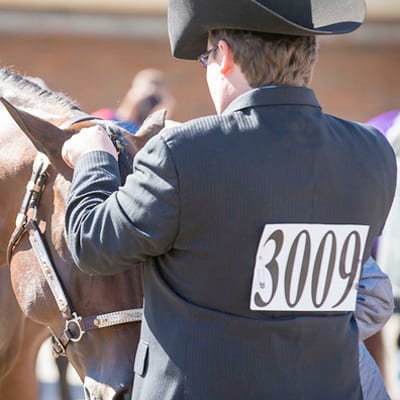I don’t know about you, but if you are going to tell me what I’m doing wrong, you better tell me what to do about it. In case you can identify with some of the behaviors in last month’s article or are just wondering how to stop the things we do to sabotage success, here are some ideas.
How to Achieve Proper Focus
Most of the top Sport Consultants and Psychologists would agree that one of the biggest obstacles to peak performance is the lack of proper focus, and quite frankly, I could write a 300 page article about it. However, the World Shows are here and many of you won’t have time to read it, so here is my simplified version.
There are three keys to maintaining proper focus or attention. The first key is to know where you need to place your attention, the second key is to be able to maintain it and the third key is to be able to shift your focus when necessary.
In simple terms, if you go looking for your attention, you can find it in one of two places, either inside or outside. It is considered ‘inside’ when you making a mental plan, a decision or talking to yourself. Your attention is said to be on the ‘outside’ when you are paying attention to the current environment and reacting to things automatically without any mental intervention. The one place you will never find your attention is both internally and externally. Your attention, just like you, can only be in one place at a time. While both areas of focus are necessary to equestrians, if we are thinking about what we need to do or how to do it, at that moment, we are not taking in any information about what is happening now, in the current moment. For the most part, we want to keep our attention outside, paying attention to the things that we need to be aware of, which are also known as task relevant cues.
A great example of this is learning how to pick up the correct diagonal. At first, you need to mentally understand what the correct diagonal is and identify the task relevant cue (inside focus). When it comes to diagonals, the task relevant cue is the position of the horses outside front leg. A common way to determine where that leg might be is by looking down and seeing the horses shoulder move (outside focus) and then you make a decision when you need to be sitting or rising (inside focus). After a short period of time, if you look down, you won’t have to think about when to rise or sit, you see the outside cue and your body naturally reacts. Then, one day, a miracle occurs! You pick up the correct diagonal because you feel it. Where problems arise is when our attention is on the inside and we are thinking about what to do or how to do it and while we are inside pontificating, we aren’t paying attention to what’s going on in the present moment, which is where we need to focus.
The first thing you need to do to sharpen your focus is to identify which task relevant cues need your attention. I’m not suggesting that you list each and every one of them, because, if something is working fine, then that implies that your attention is in the right place. The best way to know when you are not focusing on the right thing is having a coach or a trainer give you a few lessons. Listen to their instructions, and when you hear them repeating the same thing over and over, guess what? You have just found a task relevant cue that needs your focus, but just like Elvis, it’s left the building. Instead of getting down on yourself that you didn’t do it right, this is a cause for celebration! Once you zero in on something you need to pay attention to you can identify exactly what happened and then develop the correct response. Over time, just like picking up your diagonals, your response will become automatic and won’t require any of your inside attention to rectify it.
Learning to maintain your focus requires practice, both inside and outside the show pen. One of the best ways to learn to increase your focus outside the show pen is to bring your attention to your breathing, and nothing else. If you have a thought, just let it go, and refocus back on your breathing. Nothing else.
When you’re riding, practice focusing on the cues that are important, like your body position, where your horses hips are or the overall pace or cadence of each stride. If you have a wandering mind, then place “Ring Minders” around the pen. Divide the arena into 4 sections and use those sections to focus on the specific things that you have identified as most important to your performance. You may have “Eyes Up” in one section and “Heels down” in another. If you have problems shifting your attention, using Ring Minders will help you learn to easily shift your attention from one thing to another.
How to Increase Your Awareness
As I mentioned in Part 1, awareness is the process perceiving, feeling and sensing, and the best way to increase your awareness is to increase your outside focus. The other thing that increases your awareness is experience and practice. The more you ride and compete, the more sensitive you become to everything that is going on around you, which will give you plenty of time to react very smoothly to anything that comes your way.
Creating an Effective Competition Plan
I am always amazed how much smoother things go when there is a well thought out plan for each horse, rider and class. If you are spending the time and money to go to a show, then be willing to spend the time and energy to come up with a plan and communicate it to everyone who is involved. The plan should include everything from who loads what into the trailer, to the practice schedule before the class, when to lunge, clean up, get dressed and warm-up prior to the class. You will want to revisit and revise your plan if weather, lunging arena availability, or schedule changes occur. The most important thing to keep in mind is that the goal of the plan is to get the horse and rider to the in gate in the best mood possible, so take each particular situation into account when you come up with your plan.
Have a Solid Recovery Strategy
Believe it or not, things don’t always go perfectly once you are in the show pen. The key is, if you realize something is getting off track, you need to fix it and move on. We all have certain things that can trip us up, from breaking gait to overturning in a horsemanship pattern. You want to practice how you want to BE in the event something goes wrong. I didn’t say practice what you want to DO. Think about it. You can’t possibly know every thing that could go wrong, replicate it and then ride out of it. But you can practice how you want your mental state to be when things don’t go according to plan. Knowing that you will be sharp, focused and confident even after a mistake will not only get you out of a jam quickly, when you ride the way you want to be, the chance of things going awry will also diminish.
Maintain Your Physical Fitness
You are not going to learn anything new from me about how to become physically fit since there is more information about this topic than bling on small fry horsemanship shirts. Just be aware that your level of fitness affects you physically and mentally, and if you want to ride at the highest level, you need to be top shape.
Confidence Builders
Confidence is knowing that you are capable of doing something, and when it comes to horse showing, it is better to be confident that you can execute the process steps necessary to have a winning ride, not to try to be confident that you will win the class. When we focus on things outside of our control, or things that are going to happen in the future, it’s impossible to know with 100% confidence that something is going to turn out a certain way. The best way to build confidence is through practice and trust. Spending time with your horse and really get to know their moods and their quirks is probably one of the biggest and best confidence builders, and is paramount to building a winning partnership.
Practice Makes the Champion. Showing is the Easy Part.
Here is a rant a la Allen Iverson (see Part 1) that you might hear from a World Champion if you asked them about practice vs showing:
“If I can’t practice, I can’t show. It is as simple as that. It ain’t just about showing at all. It’s easy to sum it up if you’re just talking about showing. We’re sitting here, and I’m supposed to be a World Champion, and we’re talking about showing. I mean listen, we’re sitting here talking about showing, not practice, not practice, not practice, but we’re talking about showing. Not the practice that I go out there and die for and ride every practice like it’s my last but we’re talking about showing man.”
Enough said.
Kirsten Farris is a regular contributor to GoHorseShow.com and a Certified Sport Consultant, Certified Equestrian Fitness Trainer, and the Author of The Workbook for the Equestrian Athlete – A Guide to Showring Success. Kirsten and her horse, Lyles Al Lie, were the 2012 and 2013 AQHA Select World Champion in Hunter Under Saddle and Reserve World Champions in 2014. For more information contact her at: kirsten@equestrianathlete.com © 2014









